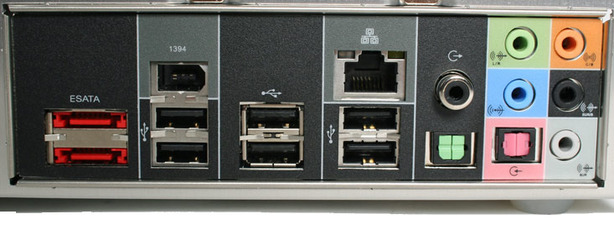Rear I/O
As is usual with Shuttle XPCs, the rear I/O is pretty packed out. You get the following on the SP35P2:- Two eSATA ports
- Six USB 2.0 ports
- One 6-pin Firewire connector
- One RJ45 socket for Gigabit Ethernet
- Optical S/PDIF in and out
- Digital S/PDIF out
- Five 3.5mm analogue audio jacks which provide the 7.1 channel surround sound
Shuttle again goes to town on the audio connections and you get both types of digital output as well as full eight-channel High-Definition support. The microphone input is through the front of the case though, as is the headphone socket which you can set to mute the speakers once it's plugged in. The only downside we've found from this is that there's a bit of background USB and SATA crosstalk interference when you use the front analogue jacks, but it's only apparent when there's nothing playing. This isn't replicated through the rear ports, either.
Shuttle has done very well on this front and we can't think of anything more we'd really need, to be honest.

BIOS
The BIOS has some very clever features – the most notable being in the auto-overclocking or, Dynamic Overclocking Control (DOC – another three letter acronym that the Taiwanese are so fond of), which at first may not sound all that unique, but when you notice that Shuttle has also included the TDP of your processor, there is some innovation in this area. The purpose of this is to let it know how hard the fans have to work to keep it cool - providing you know what that is, of course. Fortunately, some enterprising Google searching should help on this front. We tested the feature, but found that while it was great in theory, it wasn’t quite so good in practice (as is usual with these kinds of features) – manual overclocking was far more rewarding.| CPU Frequency (MHz) | 266-600 |
| PCI-Express Frequency (MHz) | 100-200 |
| CPU Dynamic Overclocking Control | 1-20% |
| CPU TDP | 65W/95W/130W/Auto |
| CPU Voltage Offset (10mV increments) | 10-500mV |
| DDR2 Voltage (0.05V increments) | 1.8-2.5V |
| FSB Voltage (0.05V increments) | 1.2-1.35V |
| Northbridge Voltage (0.05V increments) | 1.3-1.4V |
| Southbridge 1.5V Voltage (0.05V increments) | 1.5-1.65V |
| Southbridge 1.05V Voltage (0.05V increments) | 1.05-1.2V |
There's actually some very liberal voltage and frequency settings considering it’s a small form factor motherboard – no doubt helped by the fact the Core 2 CPUs are ever-so-happy when overclocking. There's plenty of CPU and memory voltage, although there's only a little extra available for the chipsets – this is understandable given the limited cooling provided.
Stability
When setup correctly this system is very stable. Even after many hours of intensive Crysis gaming over the festive period, there was not a single crash or blue screen to be had. As long as the fans have adequate airspace to circulate the air – i.e. don't shove it up against a wall – then it should happily self-regulate, even when performance tweaked. This is certainly a noteworthy achievement and one even some ATX builds can't replicate.Overclocking
This was surprisingly fruitful considering past experiences with Shuttle XPCs – we managed to get it up to 450MHz FSB, stable, with relative ease. While this is far from the best on the entire P35 scale, it's still a very good result given the limited voltages in parts. The process of finding a successful and stable overclock did actually reaffirm my affection for an ATX system though. While I may have spent hours on Crysis, the headphones glued to my ears dulled the noise from the loaded system. When finding the highest stable overclock, we load it with Prime95 for a while and go off to do something else – in this instance it was to try and get on with reading some books given to me for Christmas.This was a feat made strangely difficult by the SP35P2 – in a well built ATX system you'd likely not notice the difference between a CPU sitting idle or working its nuts off, however the SP35P2 constantly readjusts the fan speed to compensate for the heat changes, and at anything other than idle it gets really very noisy. This is made worse by the fact the extra voltage just makes things louder to compensate for the increased heat output. So while the SP35P2 can achieve a great overclock, those needing the extra speed might also find themselves investing in a good pair of headphones at the same time.

MSI MPG Velox 100R Chassis Review
October 14 2021 | 15:04










Want to comment? Please log in.